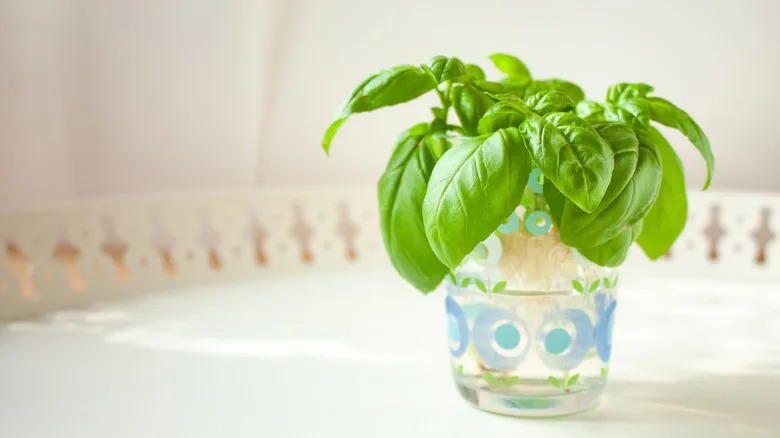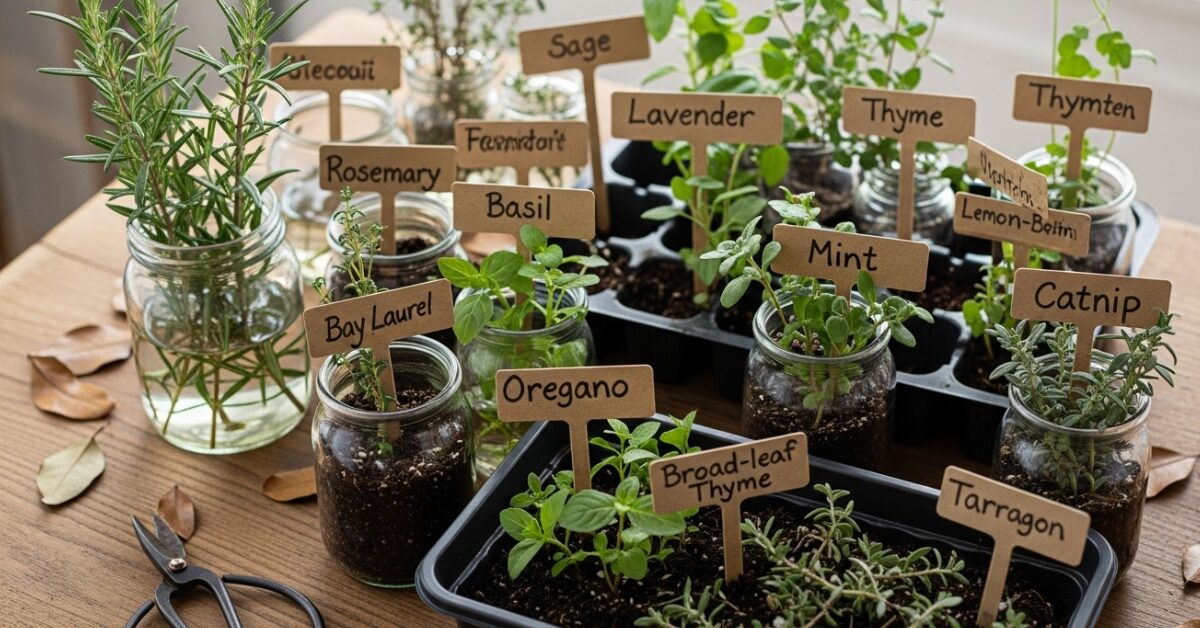Winter doesn’t have to mean the end of your herb garden. With the right approach, herbs to propagate in winter can give you a nearly continuous supply of fresh, fragrant, and flavorful plants for your kitchen and garden. Propagating herbs from cuttings is simple, requires minimal supplies, and can be done right indoors.
Whether you’re a beginner or an experienced gardener, winter is the perfect season to prepare for spring growth while keeping your indoor garden thriving.
By taking cuttings before or during winter, placing them in water or soil, and keeping them warm indoors, you can enjoy lush new plants by spring. Here’s a detailed guide to 12 herbs you can easily propagate in winter, complete with tips and tricks to ensure success.
Rosemary

Rosemary (Salvia rosmarinus) is an aromatic herb that thrives when propagated from cuttings before temperatures dip below 20°F. Take 6-inch stems from an outdoor plant, dip them in cinnamon to prevent fungus, and place them in water. Within a few weeks, roots will develop, and you can pot your new rosemary for indoor growth until spring.
Place rosemary cuttings near a sunny window for optimal growth.
Sage

Sage (Salvia officinalis) is a hardy perennial that can be propagated from hardwood cuttings while dormant. Dip cuttings in rooting hormone and place them in water or sand. Keep them on a bright windowsill, and by spring, they’ll be ready for transplanting outdoors.
Propagated sage makes a great gift for herb-loving friends.
Lavender

Lavender cuttings should be taken from older hardwood stems in late fall. Plant them in well-draining soil or water, keeping them indoors during winter. By spring, the cuttings will have grown healthy roots and can be added to your garden or indoor herb collection.
Lavender thrives with minimal water but plenty of sunlight, making it perfect for indoor winter propagation.
Thyme

Thyme (Thymus vulgaris) cuttings can root at any time indoors. Remove leaves from the bottom 2 inches and place stems in water near a sunny window. Once roots form, transfer them to pots. Thyme prefers temperatures around 68°F and grows quickly with regular trimming.
Use freshly trimmed thyme in winter dishes like soups, stews, and roasted vegetables.
Bay Laurel

Bay laurel (Laurus nobilis) requires patience but is worth the effort. Cut fall clippings, plant them in well-draining soil, and cover them with a plastic bag to retain humidity. Keep indoors through winter until roots establish.
Propagating bay laurel saves money compared to buying expensive plants from nurseries.
Basil

Basil (Ocimum basilicum) is frost-sensitive but can be propagated indoors year-round. Take cuttings from existing plants, root them in water, and transplant them when the risk of frost has passed. This creates a renewable supply of fresh basil for sauces, pestos, and salads.
Keep basil near a sunny kitchen window to maximise leaf growth in winter.
Mint

Mint (Mentha spp.) grows aggressively and is perfect for propagation. Cuttings thrive indoors during winter and can be rooted in water before being potted in soil. Avoid exposing them to frost. Once roots form, transfer the cuttings to containers to prevent spreading if planting outdoors. This approach allows for year-round harvests and ensures mint is available for teas, desserts, and culinary dishes, without worrying about invasive growth in your garden.
Oregano

The cutting of oregano ( Origanum vulgare ) roots readily in water, and thus it is a simple herb to multiply in the home during winter. Get stems that are 5 inches long, strip them of the lower leaves, and put them in water in a sunny part of a window. After the roots form, they are transferred to a small pot with soil to develop over winter. Once the soil is frozen, the plant can be removed. Indoor propagation can help gardeners keep their oregano fresh for winter use in soups, sauces, and pizza toppings.
Lemon Balm

Lemon balm (Melissa officinalis) should be pruned at the start of winter. Cut stems and place them in a small cup of water, replacing the water frequently. Once roots appear, transfer to pots. Outdoor planting should only occur after frost risk passes. Containers help prevent uncontrolled spreading. Indoor propagation ensures a continuous supply of lemon balm for teas, salads, and herbal remedies while keeping the plant manageable in your garden.
Broad-Leaf Thyme

Broad-leaf thyme (Thymus pulegioides) is easier to propagate than true thyme because it is less woody. Take 6-inch stems, remove the lower leaves, and place them in water until roots form. Transfer to pots and keep indoors through winter. Only move outside when extreme cold snaps have passed. This method ensures a reliable winter herb supply while giving beginners a high success rate for thyme propagation.
Catnip

Catnip (Nepeta cataria) grows fast and is easily propagated in water. Remove submerged leaves and refresh the water often until roots form. Transfer to a pot and allow the plant to establish indoors. By spring, the catnip is strong enough to transplant outdoors. Indoor propagation provides winter entertainment for cats and a continuous herb supply for teas or companion planting.
French Tarragon

Young stems of French tarragon can be easily propagated (Artemisia dracunculus ‘Sativa’). Remove the lower leaves and dip the cuttings in rooting hormone to be successful. In nursery pots in the house. During winter, roots grow gradually, and in spring, plants are ready to be transplanted out to the garden when the danger of frost is over. Growing French tarragon indoors keeps this aromatic herb available year-round, ideal for French dishes, marinades, and herb gardens.
Key Points for Successful Winter Herb Propagation:
- Place cuttings in bright, indirect light.
- Keep stems warm and avoid frost exposure.
- Use water or well-draining soil for rooting.
- Trim regularly to encourage bushy growth.
Propagating herbs in winter not only saves money but ensures you have fresh, aromatic herbs all year long. These 12 herbs are easy to grow, fun, and highly rewarding for indoor gardeners.
Must read: 10 Best Plants to Grow in a Greenhouse Easily
FAQs
Q1: Can you propagate herbs in winter?
Yes! Many herbs, such as rosemary, basil, mint, and thyme, can be easily propagated indoors during winter using water or soil cuttings.
Q2: Which herbs are easiest to grow from cuttings in winter?
Rosemary, sage, lavender, thyme, mint, basil, oregano, lemon balm, catnip, bay laurel, broad-leaf thyme, and French tarragon are all beginner-friendly for winter propagation.
Q3: Do I need special equipment to propagate herbs in winter?
No, all you need are small cups or nursery pots, water or soil, and a sunny windowsill. Rooting hormone and cinnamon can help boost success, but are optional.
Q4: How long does it take for herb cuttings to grow roots in winter?
Most cuttings take 1–3 weeks to develop roots, depending on the herb and indoor temperature. Keep them in a warm, bright location for the best results.




